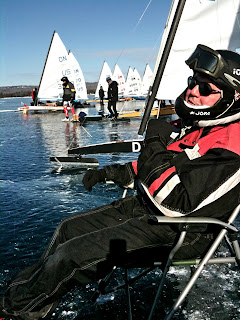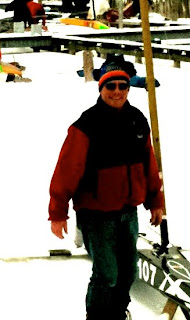

Pics 1. Moving out to the starting line. Great ice, no wind. Click to see detail.
Pic 2. Lining up hopefully... on a new line. Wind shift!
Pic 3. Pat Fitzgerald uses a critical piece of equipment on a day like this,
 his chair.
his chair.Pic 4 if there is only one, isn't it just an M?
The forecast 5-7 knot winds did not arrive, or at least stick around long. There was one silver qualifying race and three or four line resets. FInally, at 4 pm, the race committee called it a day. No one complained, it had been eight houurs on the ice at that point.
The breeze arrived just as most of the
 boats were under cover for the night. A dozen or so went back out to enjoy the 10-1 knot breezes until just before sunset at 645 pm.
boats were under cover for the night. A dozen or so went back out to enjoy the 10-1 knot breezes until just before sunset at 645 pm.The qualifying race was good, and I personally was happy with 5/6th of it. We had a light, steady breeze of just above 5 mph at the start. The left side was in a bit more breeze, and those on the right went close to shore for a lift. As it turned out, the right side made out slightly. I started in the middle of the port tack starters. Unable to run, I reached behind the boats near me, got good boat speed, and sailed fast in clear air. I tacked early, which paid off some, and tacked back to port in the middle of the boats coming in from the other side.
I rounded about 18th with great boat speed and immediately passed anothe three or four boats. I was 14th at the leeward mark, and working on passing Randy and Sam. My upwind speed and pointing were good, and I finally got by Randy as he tacked a bit before me for the mark, and I sailed a bit further and approached the mark lower and faster, Sam was hopping out of the boat at eavry tack and jibe to push the boat up to full speed. Ah to be fifteen and with two good legs. But I need to discus the "return the boat to wind propulsion" rules...
I was 13th at the leeward mark and keeping speed up well. One more boat to pass to qualify up! Again pointing well and sailing fast up wind, I passed another three boats by the windward mark. Everyone was well spread out, and some were being lapped. With great speed after rounding the weather mark, I saw the boats in front of me slowing. As the wind pressure diminished on my rig, I knew I had just left good wind, and it was moving down the lake, so I jibed. Big mistake, I lost lots of speed and had to go up to almost close hauled to get it back. I jibed back, sailed fast, but lost at least six boats, finishing 17th, or fifth after the 12 qualifiers. Boat speed is king, dummy me.
Most of the faster boats used flat sails (ABSS or JD Speed sails) and I used an FO1. Later, Pete Johns and I both experimented with sails in the light winds and bith concluded the flat sails were better in the light winds with this fast ice.
But that was all the excitement. The only other high point in the pits was finding a lost M&M. As it melted into the ice, there were interesting "worm trails" of blue carying the coating away down into the ice. Not the exciting racing we all expected, but something. Loretta is posting results, so I will not duplicate here.








































